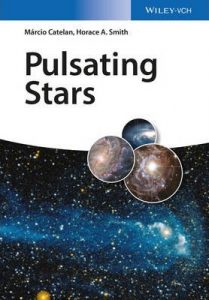THE QURAN AND THE PULSARS:PULSATING STARS
وَٱلسَّمَآءِ وَٱلطَّارِقِ
وَمَآ أَدْرَىٰكَ مَا ٱلطَّارِقُ
ٱلنَّجْمُ ٱلثَّاقِبُ
[I swear] by Heaven and the Tariq! And what will convey to you what the Tariq is? The Star Piercing [the darkness]! (Qur’an, 86:1-3)
The word “Tariq,” name of the Sura 86, comes from the root “tarq,” whose basic meaning is that of striking hard enough to produce a sound, or hitting. Bearing in mind the word’s possible meaning as “beating,” “striking hard,” our attention may be being drawn in this sura to an important scientific fact. Before analysing this information, let us look at the other words employed in the verse to describe these stars.

The term “al-taariqi” in the above verse means a star that pierces the night, that pierces the darkness, born at night, piercing and moving on, beating, striking, or sharp star. Furthermore, the term “wa” draws attention to the things being sworn on-the heaven and the Tariq.
Through research carried out by Jocelyn Bell Burnell, at Cambridge University in 1967, a regular radio signal was identified. Until that time, however, it was not known that that there was a heavenly body that could be the source of regular pulse or beating rather like that of the heart.

In 1967, however, astronomers stated that, as matter grows denser in the core as it revolves around its own axis, the star’s magnetic field also grows stronger, and thus gives rise to a magnetic field at its poles 1 trillion times stronger than that of Earth. They realised that a body revolving so fast and with such a powerful magnetic field emits rays consisting of very powerful radio waves in a conic form at every revolution. Shortly afterwards, it was also realised that the source of these signals is the rapid revolution of neutron stars. These newly discovered neutron stars are known as “pulsars.” These stars, which turn into pulsars through supernova explosions, are of the greatest mass, and are the brightest and fastest moving bodies in the universe.


Some pulsars revolve 600 times a second.51
The word “pulsar” comes from the verb to pulse. According to the American Heritage Dictionary, the word means to pulsate, to beat. Encarta Dictionary defines it as to beat rhythmically, to move or throb with a strong regular rhythm. Again, according to the Encarta Dictionary, the word “pulsate,” which comes from the same root, means to expand and contract with a strong regular beat.
Following that discovery, it was realised that the phenomenon described in the Qur’an as “tariq,” beating, bore a great similarity to the neutron stars known as pulsars.
Neutron stars form as the nuclei of super giant stars collapse. The highly compressed and dense matter, in the form of a rapidly revolving sphere, entraps and squeezes most of the star’s weight and magnetic field. The powerful magnetic field created by these rapidly revolving neutron stars has been shown to cause the emission of powerful radio waves observable on Earth.
In the third verse of Surat at-Tariq the term “al-najmu al-thaaqibu,” meaning piercing, moving on, or opening holes, indicates that Tariq is a bright star that pierces a hole in the darkness and moves on. The concept of the term “adraaka” in the expression “And what will convey to you what the Tariq is?” refers to comprehension.
Pulsars, formed through the compression of stars several times the size of the Sun, are among those celestial bodies that are hard to comprehend. The question in the verse emphasizes how hard it is to comprehend this beating star. (Allah knows best.)
As discussed, the stars described as Tariq in the Qur’an bear a close similarity to the pulsars described in the 20th century, and it reveal to us another scientific miracle of the Qur’an.
Allaah knows best.
Bashir Habeeb for knowislam.com.ng






2publisher
writing a literature review for a dissertation https://professionaldissertationwriting.org/
example of dissertation https://professionaldissertationwriting.com/
dissertation presentation https://helpwithdissertationwritinglondon.com/
online dissertation help veroffentlichen https://dissertationwritingcenter.com/
dissertation help free https://dissertationhelpexpert.com/
write your dissertation https://accountingdissertationhelp.com/
help dissertation https://examplesofdissertation.com/
marketing acknowledgement https://writing-a-dissertation.net/
dissertation proposal writing services https://bestdissertationwritingservice.net/
dissertation help free https://businessdissertationhelp.com/
help me https://customdissertationwritinghelp.com/
psychology dissertation https://writingadissertationproposal.com/
dissertation help in delhi https://dissertationhelpspecialist.com/
dissertation handbook https://dissertationhelperhub.com/
dissertation writing fellowships https://customthesiswritingservices.com/
casino online nj https://download-casino-slots.com/
lucky creek online casino https://firstonlinecasino.org/
online casino with free signup bonus real money usa no deposit https://onlinecasinofortunes.com/
online casino welcome bonus https://newlasvegascasinos.com/
river online casino https://trust-online-casino.com/
vegas casino online $100 no deposit bonus codes 2021 https://onlinecasinosdirectory.org/
best usa online casino 2021 https://9lineslotscasino.com/
safe online casino https://free-online-casinos.net/
platinum reels online casino https://internet-casinos-online.net/
pa online casino apps https://cybertimeonlinecasino.com/
lucky nugget online casino https://1freeslotscasino.com/
online casino live roulette https://vrgamescasino.com/
hallmark online casino https://casino-online-roulette.com/
live online casino usa https://casino-online-jackpot.com/
10 dollar minimum deposit usa online casino https://onlineplayerscasino.com/
sicheres online casino https://ownonlinecasino.com/
live online casino usa https://all-online-casino-games.com/
lotus casino online https://casino8online.com/
what does vpn mean https://freehostingvpn.com/
windows vpn https://ippowervpn.net/
vpn ip address free https://imfreevpn.net/
vpn configuration windows free https://superfreevpn.net/
free russian vpn https://free-vpn-proxy.com/
what is vpn service https://rsvpnorthvalley.com/
dating guys wen 18 gay https://gay-singles-dating.com/
which senoir gay dating app has most members lakeland fl https://gayedating.com/
newest gay dating site https://datinggayservices.com/
top date sites https://freephotodating.com/
subtle asian dating https://onlinedatingbabes.com/
adult dating https://adult-singles-online-dating.com/
date women free https://adult-classifieds-online-dating.com/
free dating sites for men and women https://online-internet-dating.net/
faroedating chat https://speedatingwebsites.com/
free dating sites for men and women https://datingpersonalsonline.com/
free single site https://wowdatingsites.com/
lightdatings life https://lavaonlinedating.com/
dating sites that are totally free https://freeadultdatingpasses.com/
match single https://virtual-online-dating-service.com/
free sex chat sites https://zonlinedating.com/
n dating site https://onlinedatingservicesecrets.com/
online casino uk https://onlinecasinos4me.com/
online casino games that pay real money https://online2casino.com/
free bonus without deposit online casino https://casinosonlinex.com/
frree gay and bi chat sites in seattle wa https://newgaychat.com/
gay perv chat group https://gaychatcams.net/
free chat for gay curius people https://gaychatspots.com/
gay bear chat https://gay-live-chat.net/
gay fl chat https://chatcongays.com/
gay advise chat https://gayphillychat.com/
cleveland gay chat https://gaychatnorules.com/
what does the diamond emoji mean in gay chat https://gaymusclechatrooms.com/
gay boy teen webcam chat https://free-gay-sex-chat.com/
gay chat zone https://gayinteracialchat.com/
gay chat roulette adult https://gaymanchatrooms.com/
write my papers discount code https://term-paper-help.org/
buy resume paper https://uktermpaperwriters.com/
best paper writers https://paperwritinghq.com/
where to buy resume paper https://writepapersformoney.com/
buy a college paper https://write-my-paper-for-me.org/
write my paper reviews https://doyourpapersonline.com/
paper writers college https://top100custompapernapkins.com/
i don’t want to write my paper https://researchpaperswriting.org/
someone write my paper for me https://cheapcustompaper.org/
help with writing a paper for college https://writingpaperservice.net/
buying college papers online https://buyessaypaperz.com/
buy cheap paper https://mypaperwritinghelp.com/
write my paper fast https://writemypaperquick.com/
buy school papers https://essaybuypaper.com/
paper writing help online https://papercranewritingservices.com/
help write my paper https://premiumpapershelp.com/
college paper writing service https://studentpaperhelp.com/
1indelible
coursework writers https://brainycoursework.com/
coursework history https://courseworkninja.com/
coursework sample of written work https://mycourseworkhelp.net/
creative writing english coursework https://courseworkdownloads.com/
coursework in english https://courseworkinfotest.com/
creative writing coursework ideas https://teachingcoursework.com/
differential equations coursework https://buycoursework.org/
degree coursework https://courseworkdomau.com/
dating sites that are totally free https://freewebdating.net/
personal ads dating https://jewish-dating-online.net/
dating sites for free https://jewish-dating-online.net/
internet dating site https://free-dating-sites-free-personals.com/
free dating sites no payment https://sexanddatingonline.com/
dating dating https://onlinedatingsurvey.com/
online dejting https://onlinedatingsuccessguide.com/
free local personals https://onlinedatinghunks.com/
farmersonly https://allaboutdatingsites.com/
online singles dating sites https://freedatinglive.com/